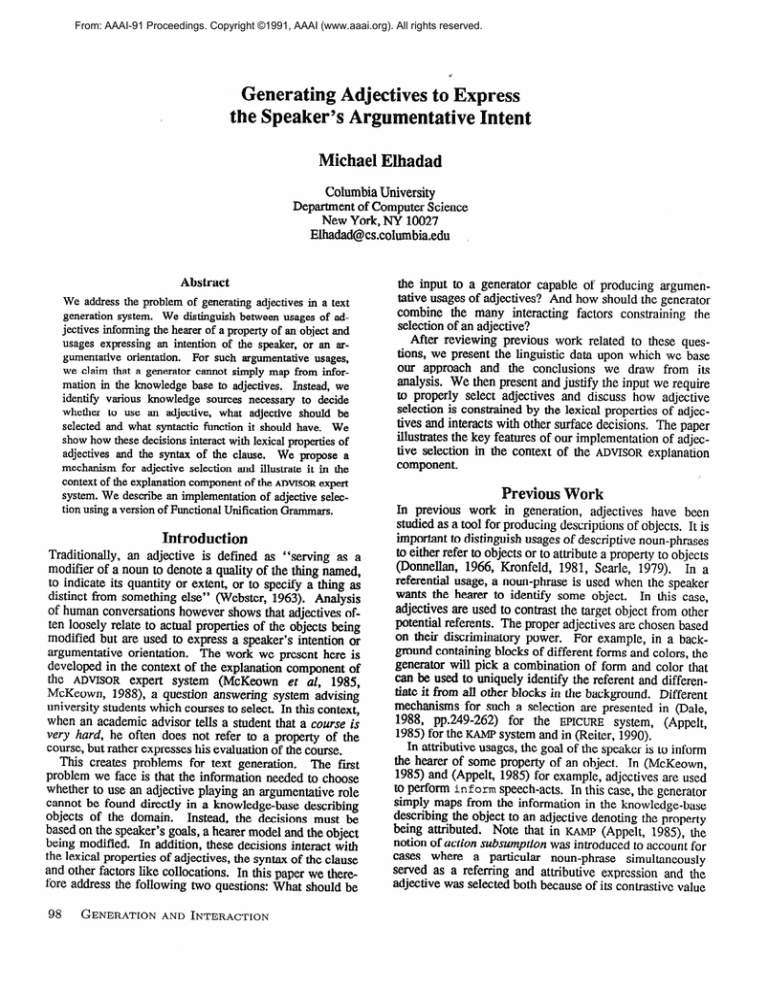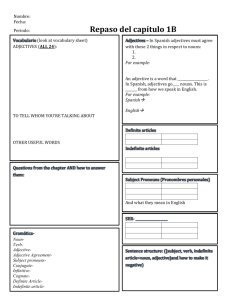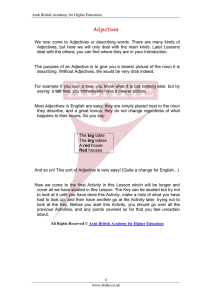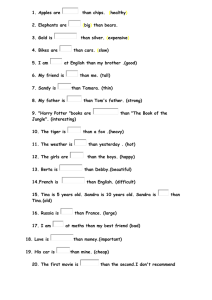
From: AAAI-91 Proceedings. Copyright ©1991, AAAI (www.aaai.org). All rights reserved.
Generating Ad&e ives towExpress
the Speaker’s Ar
entative Intent
Michael Elhadad
Columbia University
Department of Computer Science
New York, NY 10027
Elhadad@cs.columbia.edu
Abstract
We address the problem of generating adjectives in a text
generation system. We distinguish between usages of adjectives informing the hearer of a property of an object and
usages expressing an intention of the speaker, or an argumentative orientation. For such argumentative usages,
we claim that a generator cannot simply map from information in the knowledge base to adjectives. Instead, we
identify various knowledge sources necessary to decide
whether to use an adjective, what adjective should be
selected and what syntactic function it should have. We
show how these decisions interact with lexical properties of
adjectives and the syntax of the clause. We propose a
mechanism for adjective selection and illustrate it in the
context of the eXpktnatiOn component of the ADVISOR expert
system. We describe an implementation of adjective selection using a version of Functional Unification Grammars.
Introduction
Traditionally, an adjective is defined as “serving as a
modifier of a noun to denote a quality of the thing named,
to indicate its quantity or extent, or to specify a thing as
distinct from something else” (Webster, 1963). Analysis
of human conversations however shows that adjectives often loosely relate to actual properties of the objects being
modified but are used to express a speaker’s intention or
argumentative orientation. The work we present here is
developed in the context of the explanation component of
the ADVISOR expert system (McKeown et al, 1985,
McKeown, 1988), a question answering system advising
university students which courses to select. In this context,
when an academic advisor tells a student that a course is
very hard, he often does not refer to a property of the
course, but rather expresses his evaluation of the course.
This creates problems for text generation. The first
problem we face is that the information needed to choose
whether to use an adjective playing an argumentative role
cannot be found directly in a knowledge-base describing
objects of the domain. Instead, the decisions must be
based on the speaker’s goals, a hearer model and the object
being modified. In addition, these decisions interact with
the lexical properties of adjectives, the syntax of the clause
and other factors like collocations. In this paper we therefore address the following two questions: What should be
98
GENERATION
AND
INTERACTION
the input to a generator capable of producing argumentative usages of adjectives? And how should the generator
combine the many interacting factors constraining the
selection of an adjective?
After reviewing previous work related to these questions, we present the linguistic data upon which we base
our approach and the conclusions we draw from its
analysis. We then present and justify the input we require
to properly select adjectives and discuss how adjective
selection is constrained by the lexical properties of adjectives and interacts with other surface decisions. The paper
illustrates the key features of our implementation of adjective S&CtiOn in the COnteXt Of the ADVISOR CXphatiOn
component.
rwious
ork
In previous work in generation, adjectives have been
studied as a tool for producing descriptions of objects. It is
important to distinguish usages of descriptive noun-phrases
to either refer to objects or to attribute a property to objects
(Donnellan, 1966, Kronfeld, 1981, Searle, 1979). In a
referential usage, a noun-phrase is used when the speaker
wants the hearer to identify some object. In this case,
adjectives are used to contrast the target object from other
potential referents. The proper adjectives are chosen based
on their discriminatory power. For example, in a background containing blocks of different forms and colors, the
generator will pick a combination of form and color that
can be used to uniquely identify the referent and differentiate it from all other blocks in the background. Different
mechanisms for such a selection are presented in (Dale,
1988, pp.249-262) for the EPICURE system, (Appelt,
1985) for the KAMPsystem and in (Reiter, 1990).
In attributive usages, the goal of the speaker is to inform
the hearer of some property of an object. In (McKeown,
1985) and (Appelt, 1985) for example, adjectives are used
to perform inform speech-acts. In this case, the generator
simply maps from the information in the knowledge-base
describing the object to an adjective denoting the property
being attributed. Note that in KAMP(Appelt, 1985), the
notion of action subsumption was introduced to account for
cases where a particular noun-phrase simultaneously
served as a referring and attributive expression and the
adjective was selected both because of its contrastive value
and of its informative value.
Other works have studied usages that are neither attributive nor referential in the sense discussed above. With
PAULINE, Hovy (Hovy, 1988) discussed the use of adjectives to satisfy pragmatic constraints. For example, the
generator could produce a sentence like poor John was
severely beaten by the police where poor does not denote
any information about John but rather expresses the orientation of the speaker. Hovy covered many different linguistic devices satisfying pragmatic constraints and as a
result provides only a very superficial treatment of adjective selection (he devotes a single paragraph to its discussion).
In (Bruxelles et al, 1989) and (Bruxelles & Raccah,
1991), a model for describing the argumentative potential
of lexical items is introduced. This model aims at explaining how adjectives like courageous express both a property
of the modified object and an argumentative orientation of
the speaker (a favorable evaluation of the object), whereas
adjectives like intrepid or bold while conveying roughly
the same information also convey a different orientation.
The reported work is still at early stages and is oriented
We use here many concepts
towards interpretation.
derived from this work and examine its implications on
generation.
In earlier work, we have studied the problem of generating certain connectives like but, although, because or since
(McKeown & Elhadad, 1991, Elhadad & McKeown,
1990). We identified a set of pragmatic features necessary
to distinguish between these connectives, including argumentative features. In this paper, we refine this work
and identify features to adequately select a certain class of
adjectives.
I
Originally, our task was to extend the linguistic coverage
of the generator for the explanation component of the
ADVISOR expert system to select adjectives based on
general principles. ADVISORiSa system that assists university students select courses and plan their semester
(McKeown, 1988).
We performed an analysis of a corpus of 40,000 words
containing transcripts of recordings of advising sessions
with human academic advisors. In this corpus, we identified approximately 700 occurrences of 150 distinct adjectives. We focused our analysis on all occurrences of adjcctives modifying a course, in both predicative and attributive positions. We found 69 such occurrences, of 26 distinct adjectives. Figure 1 shows a break down of these
occurrences in semantic classes.
Of the 69 occurrences listed in Figure 1, 58 express a
property of a course that one cannot reasonably expect to
find in the knowledge-base describing courses. For example, it is problematic to describe a course as good or
hard in absolute terms. For most of the occurrences therefore, the technique of mapping from a semantic property in
the knowledge-base to an adjective, as used in previous
generation systems to produce attributive noun-phrases,
would not be applicable. Most of the usages of adjectives
in the corpus correspond to an argumentative usage. For
example, the advisor qualifies a course as hard when he
wants to discourage a student from taking it. The selection
of hard in this context is related to the underlying goal of
the advisor in addition to the objective properties of the
course and to the level of the student as evaluated by the
advisor (the same course is not hard for all students).
Semantic class
hportanm 1241
1
Evaluative [lo]
L
theory
1
computing
1
Mist [3]
Figure 1: Adjectives modifying courses in corpus
ELHADAD
99
Needed
ctive
We therefore cannot expect the input to the surface generator to simply be attribute the property P to a course if we
want to be able to generate adjectives in argumentative
contexts. We examine in this section what information
needs to be provided to a generator to adequately select an
adjective in such contexts.
Consider the difference between the adjectives hard and
difficult. In our corpus, hard was consistently used in contexts where the advisor was discouraging the student from
taking a course, as in the following examples?
Data Structure is probably the hardest course and
you would want to make sure that you could handle it.
There is no law against taking Data Structures without having .. . [pause] but it is a very hard course.
In contrast, di#icult was used in more neutral contexts,
where the advisor did not commit to a particular evaluation
of the course:
I really can’t tell you how dificult or easy they are:
I think they’re both at the same level and I don’t think
there’s much diflerence in terms of what’s easier and
more difficult.
Hard and dificult convey a very similar information on the
course. However, hard is argumentatively marked, while
dificult is neutral. If we want our generator to be capable
of distinguishing between these two adjectives, we need to
provide the argumentative intent of the speaker in the input.
The description of this intent needs to be scalar and
relative to a background.
Adjectives in argumentative
usages are used in comparative constructs and with intensifiers. These factors point to the scalar nature of the
argumentative moves realized by adjectives. We therefore
use a notion of scale in our representation of the argumentative intent of the speaker (cf (McKeown & Elhadad,
1991, Elhadad & McKeown, 1990) for details on scales).
In addition, many linguists have distinguished between
absolute and relative adjectives (Bartsch, 1989, Huebler,
1983, p.37). The meaning of relative adjectives depends
on the object being modified (a small elephant is a big
animal) whereas absolute adjectives keep the same denotation for all objects they modify (a red box is as red as a red
book). For relative adjectives, an evaluation norm needs to
be identified. This norm can be explicitly stated as in Data
Structures is the hardest of the undergrad courses or this
course would be perfect for you. But it can also be left
‘All examples iu the paper are taken from our corpus unless otherwise
mentioned.
100
GENERATION AND
INTERACTION
implicit as in this course is fkirZy advanced where the
evaluation norm determining what is advanced depends on
the model the speaker has of the student. In the ADVISOR
domain, we have found that relative adjectives depend not
only on the object being modified (a good course is not
good in the same sense as a good meal) but also depend on
a model of the hearer: a challenging course for an undergrad could be easy for a graduate student, a programming
project could be very difficult for a student lacking programming experience.
A Formal Representation for Argumentative Intent
We need a way to represent the argumentative orientation
of a speaker in a way that captures both its scalar nature
and its relativity. We now present a representation using
the FUG notation that satisfies these requirements
Notation: The notation used is that of functional
descriptions (FDS) used in Functional Unification Grammars (FUGs)(Kay, 1979, Elhadad, 199Oa). Figures 2 and 3
illustrate the notation. Each attribute in a complex FD can
be described by an embedded FD. In the pair ( f ecus {ao
scope
attribute) 1 S the {) notation indicates that
focus is a pointer to the value of the attribute of the
scope of the ao in the FD. When such a pointer is used,
the two attributes actually share a unique value. The cat
attribute identifies the type of the denoted objects. Note
that FUF,the version of FUG we have developed is typed
(Elhadad, 199Ob) and V&NZS like course and student
are actually part of a type lattice.
For example,
undergrad-student
is a specialization of the type
student.
Input specifying the argumentationfor
AI is hard (for a course)
(.. .
t; Arg orientation of the utterance
(a0
( (scope
((process-type
attributive)
(carrier ((cat course)
(name AI)))
(attribute nil)))
(focus {ao scope attribute})
(scale difficulty)
(orientation +)
(reference-variable
((constraint
(a0 scope carrier})
(range ((cat course))))))))
Figure 2: Input with argumentative specifications
An argumentative orientation (AO) is a representation in
intension of a partially ordered set of propositions. We use
6 features to represent an AO. Intuitively, the A0 specifies
that a certain proposition is a stronger argument for a certain class of conclusions than all the propositions defined
in this set. A logical notation for the set denoted by Figure
2 is:
AO= (attributive(C,A)lA E Scale-dtflculty A C E Courses)
where Scale-diflculty denotes the set of all degrees on the
scale of difficulty and Courses denotes the set of all
courses. In our notation, the pattern common to all elements of the set A0 is represented by the scope feature.
The elements of the set A0 are ordered by first projecting
each proposition on the role pointed to by the focus feature. Intuitively, the notion of focus is best illustrated by
comparing the sentences: even John came and John even
came. In the first one, John is the focus of the argument,
whereas in the second one came is the focus. The projections are degrees of the set denoted by the scale feature
and the orientation feature indicates what ordering
relation is used to compare them. This technique of comparing complex propositions is similar to the techniques
used in (Cresswell, 1976) and (Kay, 1987).
The role of the last two features reference-variable
and reference-set is to constrain the range of the variable C in a way similar to how the focus variable A is
constrained by the quantification over the scale. For example, Figure 3 can be represented by the following logical
formula:
AO= (attributive(C,A)b
E Scale-di#%.dty A C E Ref
Ref= {X13S, undergrad-student(S) A take(S,X))
Intuitively, we limit the values of the carrier of the
scope
to be within the range of courses that
undergrad-students
Can take. The A0 SpWifiCatiOn
can therefore be read as AI is hard compared to the courses
that undergrad students take. The input specification in
Figure 3 can be derived from the simpler one in Figure 2
by the addition of information from a user model.
Input forAI
is hard for an undergrad
(...
(a0
( (scope
((process-type
attributive)
(carrier ((cat course)
(name AI)))
(attribute nil)))
(focus {ao scope attribute})
(scale difficulty)
(orientation +)
(reference-variable
((constraint
(a0 scope carrier))
(range {ao reference-set
medium})))
(reference-set
((process-type
action)
(process take)
(agent ((cat undergrad-student)))
(medium ((cat course))))))))
Figure 3: A0 relative to the user-model
cussion of the semantics of scales and how they capture the
scalar nature of argumentation.
In the previous section, we have identified the information
needed in the input in order to select an adjective and we
have presented a representation for this information. We
now turn to the information that needs to be present in the
lexicon to describe adjectives. Linguistic studies have
identified many different classes of adjectives, based on
their semantic or syntactic behavior. We focus on lexical
properties that constrain how adjectives can be used to
convey an argumentative meaning and show the type of
lexical representation we use for adjectives.
In general adjectives can occur in either attributive or
predicative position (Quirk et al, 1972, p.231). Certain
adjectives however can only be used in predicative position
(e.g., mere), only in attributive position or can have a different meaning if used in predicative or attributive
position.2 Such properties need to be encoded in the lexicon.
In (Bohnger, 1972, p.21), Bolinger distinguishes between
degree and non-degree adjectives. In our domain, required
is an example of non-degree adjective (there is an official
legal definition of what a required course is for the major),
whereas important, hard or interesting are all degree adjectives. Non-degree adjectives cannot be used with intensifiers like very and cannot be used in comparative forms.
This lexical classification limits the range of adjectives
capable of being used for argumentative purposes.
Using different terms, linguists in (Givon, 1970),
(Rusiecki, 1985, p.13 J) and (Huebler, 1983, p.38) have
distinguished between marked and neutral adjectives. In
our domain, this distinction is illustrated by the difference
between hard and dt&Q’cuZt. Note however that while
difficult tends to be used as a neutral adjective, it can be
marked if it is intensified (lie in it is a very dijj?cult class).
This lexical property distinguishes among adjectives conveying the same information those that can be used to convey an argumentative meaning.
Certain adjectives can be presented as absolute in surface.
For example, interesting was consistently used in our corpus without any qualification or complement:
What is that course? It looked very interesting
It would be an interesting course. I mean, Z think
Mathematical Logic is pretty [pause] interesting.
In contrast, good was always used with a complement explicitly relativizing its meaning:
So that might be a good class for you to take next
This formalism is general enough to capture the relativity
of argumentation both in terms of the object being
modified and in terms of information found in a usermodel. We refer the reader to (Elhadad, 199Oc) for a dis-
2For exampleold in an oldfriend is the opposite of new, whereas in My
jkiend is old it is the opposite of young.
ELHADAD
101
semester if you take A? this semester.
Ifyou’re good at math - that might be a good course
to take.
Note that this distinction is only at the surface: there is
good reason to consider interesting as a relative adjective
in the semantic sense introduced above and many semantically relative adjectives do not require or prohibit an explicit complement at the surface. This property of good
and interesting is therefore unpredictable from their
semantics. But it constrains the way these adjectives can
be used.
At the semantic level, the lexicon specifies the mapping
from semantic scales to the adjectives that can express
In addition, it specifies what objects can be
them.
modified by what scales.
Similar to these selection restrictions but at the lexical
level, lexical affinities or collocations (Smadja, 1991) can
constrain what words can be used along with adjectives.
For example, a course can be strongly recommended 01:
very important (Bolinger, 1972, ~~21-57). The choice of
the intensifier is constrained by the adjective. Such lexical
affinities need to be captured in the lexicon for the adjectives to be properly used.
Figure 4 shows an example of lexical entry for the adjective hard. We do not discuss here how all lexical entries
are organized and indexed into a large lexicon. For the
semantic section of this entry, the object feature Contains
the semantic class of the object being modified. The alt
construct (the disjunction operator in FUG) liststhe semantic classes compatible with the adjective. For each type of
object, the argumentative scale triggered by hard is different. For hard, the Webster dictionary lists 13 different
meanings corresponding roughly to different scales. This
semantic description needs to be adapted to different
domains.
Interaction with other Surface Decisions
The selection of adjectives is only one of many choices
made when generating a clause. We discuss in this section
some syntactic factors that determine whether to use an
adjective at all to satisfy an argumentative intent and constrain what adjective can be used when necessary.
Consider the following examples:
I struggled with AI. (I took AI + Ifound AI hard.)
I enjoyed AI. (I took M + I found AI interesting.)
In these two sentences, the verb lexically carries an argumentative evaluation of its object. In these cases, there
is no need to use an adjective, a semantically rich verb can
express both the information that the course was taken and
the speaker’s evaluation of the course.
In contrast, consider the following example where the
advisor is asked what course follows Introduction in the
102
GENERATION
AND INTERACTION
((cat adjective)
(lex "hard")
: ; Compatible semantic classes
I';that can be modified
(object ((alt (((cat course))
((cat material))
((cat liquor))
. . .)))I
r'
r' Depending on semantic class of
;; object, semantic scale triggered
* by the adjective
ikt
(
l
((object ((cat course)))
(ao ((scale difficulty)
(orientation +))))
((object ((cat material)))
(a0 ((scale pressure-resilience)
(orientation +))))
. ..)I
;; No collocation constraints
;; on intensifier: use default
(intensifier
nil)
(degree yes)
(marked yes)
(relative yes)
(require-complement
no)
; ; can be used both in predicative
l
* and attributive position
iiredicative
(attributive
yes)
yes))
Figure 4: Fragment of the lexicon
curriculum:
Data structures follows Intro, and it is a very difficult
course.
Since there is no verb that can express both the notion of
succession and the evaluation of the course, the generator
must resort to using an adjective in this case.
These examples illustrate how the argumentative orientation constraint specified in the input can be realized at
different levels in the syntactic structure of the clause.
This explains why we represent the ~0 feature in the input
as a top level feature and not embedded under the description of the object it modifies. The non-locality of the argumentative constraint presents interesting challenges to a
text generator in terms of control. We explain in (Elhadad
& Robin, 1991) how FUF has been extended to handle this
type of choice.
The decision of using an adjective also interacts with the
choice of the head of the noun phrase being modified. For
example, proper nouns cannot be pre-modified by adjectives, and require the grammar to choose either a relative
clause, an apposition or a predicative construct. The decision to use the adjective in predicative or attributive posi-
tion also depends on the lexical properties of the adjective.
Finally, the decision to explicitly express the relativity
of the adjectival modification (does the generator produce
AI is hard or AI is hard for an undergrad course) depends
on what information is encoded in the reference
variable and reference-set
features and the lexical
properties of the adjective (whether it requires a complement and what forms of complements it can support).
inin
The grammar we use encodes both the lexicon and the
syntactic resources. Its function is to combine all the constraints specified in the input, the lexicon and the syntax
into a single consistent clause.
The mechanism of constraint combination is handled by
unification. Because the grammar must express many different constraints, coming from many different sources
(lexical properties of the verb, of the adjective, of the
modified noun, position of the adjective, use of a connective etc) we found the FUG formalism particularly well
adapted to the problem. It is indeed possible to express
each source of constraints independently and the constraint
satisfaction mechanism of FUG takes care of the interactions that can exist between them (cf (McKeown & Elhadad, 1991) for a discussion and a comparison of FUG
with other formalisms).
We have used the grammar that we developed earlier for
the COMET system (McKeown et al, 1990) and extended it
to include treatment of adjectives. The flow of control
used to traverse the grammar is described in details in (Elhadad & Robin, 1991). The main challenge we met when
developing the grammar was the non-structural nature of
the argumentative constraint in the input, and it required
the development of new control tools implemented in our
implementation FUG,FUF (Elhadad, 1990a).
Conclusion and Future
We have shown that adjectives are often used to convey
the argumentative intent of the speaker in addition to conveying information about objects. We have proposed a
formal representation of the argumentative orientation of
an utterance, that can serve as an input to a surface generator to decide whether to use an adjective and what adjective to select. We have listed what lexical information is
required to describe adjectives for the generator and some
aspects of the clause generation that interact with the decision to use an adjective serving an argumentative function.
The lexical properties of adjectives, when not readily accessible in dictionaries, can be found by analyzing corpora
of existing conversations. We have analyzed such a corpus
of 40,000 words, and derived a characterization of 26 distinct adjectives in our domain. In order to extend the
coverage of our system, we plan on analyzing larger corpora.
The model we have presented is partially implemented
in the explanation component of the ADvIsoR expert system, using FUF, our implementation of FUGS. We are cur-
rently pursuing this implementation in several directions.
A deep generator is being developed to produce the inputs
we have described, taking a user model into account. We
are investigating circumstances under which intensifiers
are used and what pragmatic effects are produced when a
complement is added to an adjective (a construct like hard
for an undergrad presupposes something about undergrads).
Ac~~o~Iedg~e~~s. This work was supported by DARPA
under contract NOOO39-84-C-0165, by NSF Grant
IRT-84-5 1438 and by ONR Grant NOOO14-89-J-1782.
I would like to thank Kathy MC&own, Rebecca Passoneau, Jacques Robin and Frank Smadja for their help and
for insightful comments on previous versions of this paper.
eferenses
Appelt, D.E. (1985). Planning English Sentences. Studies
in Natural Language Processing.
Cambridge,
England: Cambridge University Press.
Bartsch, R. (1989). Semantics and Contextual Expression.
Dordrecht, Holland; Providence, RI: Foris Publications.
Bolinger, D. (1972). Degree Words. The Hague: Mouton.
Bruxelles, S. and Raccah P.Y. (1991). Argumentation et
Semantique: le parti-pris du lexique. In Actes du
Colloque ‘Enonciation et parti-pris’ . Forthcoming.
Bruxelles, S., Carcagno, D. and Foumier, C. (1989). Vers
une construction automatique des topoi a partir du
lexique. CC AI - Journal for the integrated study of
Artificial Intelligence cognitive science and applied
epistemology, 6(4), 309-328.
Cresswell, M.J. (1976). The semantics of degree. In
Partee, B.H. (Ed.), Montague Grammar. New York:
Academic Press.
(1988). Generating referring expressions in a
domain of objects and processes. Doctoral disser-
Dale, R.
tation, University of Edinburgh.
Donnellan, KS. (1966). Reference and Definite Description. Philosophical Review, 75,28 I-304.
Elhadad, M. (June 1990). The FUF Functional Unifier:
(Tech. -Rep.
User’s
manual
(Version
3.0)
CUCS-012-91). Columbia University.
Elhadad, M. (1990). Types in Functional Unification
Grammars. Proceedings of 28th Meeting of the ACL
(ACL’90). Pittsburgh.
(I990). Constraint-based Text Generation:
Using local Constraints and Argumentation to
Generate a Turn in Conversation (Tech. Rep.
Elhadad, M.
CUCS-003-90). Columbia University.
ELHADAD
103
Elhadad, M. and K.R. McKeown. (1990). Generating Connectives. Proceedings of COLING’90 (Volume 3).
Helsinki, Finland.
Elhadad, M. and Robin, J. (1991). Control in Functional
Unification Grammars for Text Generation (Tech.
Rep. CUCS-011-91). Columbia University, Dept of
Computer Science.
Givon, T. (1970). Notes on the semantic structure of
English adjectives. Language, 46(4), 816-837.
(1988). Generating natural language under
pragmatic constraints. Hillsdale, NJ.: L. Erlbaum
Hovy, E.H.
Associates. Based on the author’s thesis (doctoral-Yale University, 1987).
Huebler, A. (1983). Pragmatics and Beyond.
Evaluation of Functional Unification Grammar for
Surface Language Generators: A Case Study in
Choice of Connectives. In C. Paris et al (Eds.),
Natural Language Generation in Al and Computational Linguistics. Kluwer Academic Publishers.
McKeown, K.R., Wish, M., and Matthews, K. (1985).
Tailoring Explanations for the User. Proceedings of
the IJCAI. IJCAI.
McKeown, K., Elhadad, M., Fukumoto, Y., Lim, J., Lombardi, C., Robin, J. and Smadja, F. (1990). Language Generation in COMET. In Mellish, C. and
Dale, R. and Zock, M. (Ed.), Current Research in
Language Generation.
London, UK: Academic
PESS.
Vol. IV:&
Understatements and Hedges in English. Amsterdam: John Benjamins Publishing Company.
Quirk, R. et al.
(1972). A Grammar of Contemporary
English. Longman.
Kay, M. (1979). Functional Grammar. Proceedings of the
Reiter, E. (June 1990). The Computational complexity of
Avoiding Conversational Implicatures. Proceedings
5th meeting of the Berkeley
Linguistics Society.
Berkeley Linguistics Society.
Kay, Paul. (July 1987). Even.
Berkeley.
University of California,
the Conceptual-Descriptive
Theory
of
Doctoral dissertation, University of California, Berkeley.
(1985). Text Generation: Using Discourse Strategies and Focus Constraints to Generate
Natural Language Text. Studies in Natural Lan-
McKeown, K.R.
guage Processing. Cambridge, England: Cambridge
University Press.
McKeown, K.R. (1988). Generating Goal oriented Explanations. International Journal of Expert Systems,
l(4), 377-39s.
McKeown, K. and M. Elhadad.
104
GENERATION
AND
burgh, Pittsburgh, PA: ACL.
Rusiecki, J.
Kronfeld, A. (1981). The Referential-Attributive distinction and
Reference.
of the 28th meeting of the Association for Computational Linguistics (ACL’BO). University of Pitts-
(1991). A Contrastive
INTERACTION
English:
(1985). Adjectives and Comparison in
a semantic study. England: Longman.
(Longman Linguistics Library).
Searle, J.
(1979). Referential
and Attributive.
In
Expression and Meaning: Studies in the Theory of
Speech-Acts.
Cambridge: Cambridge University
Press.
(February 1991). Retrieving Collocational
Knowledge from Textual Corpora. An Application:
Language Generation.. Doctoral dissertation, Com-
Smadja, F.
puter Science Department, Columbia University.
(1963). Webster’s Seventh New Collegiate Dictionary (1963 ed.).
Springfield, MA:
Merriam Webster.
Merriam Webster.






